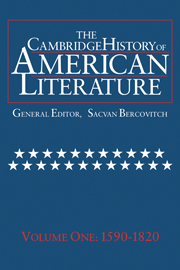Book contents
- Frontmatter
- Introduction
- THE LITERATURE OF COLONIZATION
- NEW ENGLAND PURITAN LITERATURE
- 1 The Language of Salem Witchcraft
- 2 The Dream of a Christian Utopia
- 3 Personal Narrative and History
- 4 Poetry
- 5 The Jeremiad
- 6 Reason and Revivalism
- BRITISH-AMERICAN BELLES LETTRES
- THE AMERICAN ENLIGHTENMENT, 1750–1820
- THE LITERATURE OF THE REVOLUTIONARY AND EARLY NATIONAL PERIODS
- Chronology
- Bibliography
- Index
5 - The Jeremiad
from NEW ENGLAND PURITAN LITERATURE
Published online by Cambridge University Press: 28 March 2008
- Frontmatter
- Introduction
- THE LITERATURE OF COLONIZATION
- NEW ENGLAND PURITAN LITERATURE
- 1 The Language of Salem Witchcraft
- 2 The Dream of a Christian Utopia
- 3 Personal Narrative and History
- 4 Poetry
- 5 The Jeremiad
- 6 Reason and Revivalism
- BRITISH-AMERICAN BELLES LETTRES
- THE AMERICAN ENLIGHTENMENT, 1750–1820
- THE LITERATURE OF THE REVOLUTIONARY AND EARLY NATIONAL PERIODS
- Chronology
- Bibliography
- Index
Summary
By the time of the Restoration of Charles II in England in 1660, Puritan New England had developed into a relatively prosperous, stable, and independent colony. Some who had left for England during the Protectorate returned to New England after 1660, and other English Puritans, like Edward Taylor, fled to America to escape renewed Anglican persecution. With the native tribes still traumatized by the violence of the Pequot War in the late 1630s, Puritan villages proliferated, and different local governments, customs, and economies replicated the various peasant cultures of places such as Yorkshire, Kent, East Anglia, and the West Country of England. On the whole, travelers in New England in the 1650s described flourishing agricultural communities of pious, hardworking families where the churches and the state appeared to cooperate in governance.
In larger cities such as Boston and Salem, there arose a merchant class based upon manufacturing, the fishing industry, and foreign trade, while the rural villages remained dependent upon farming. Open-field farming continued in some areas until the late seventeenth century, but most land was converted to small individual holdings. Because Congregationalism encouraged village independence, forms of government were quite varied, with selectmen sometimes possessing broad powers, and in many the influence of the ministers upon civil decisions was diminishing.
This slow process of secularization was hastened and became more dramatic when two serious difficulties arose that would precipitate drastic changes in the social and religious order between 1660 and 1690: a land shortage and growing religious uncertainties among the young. Word of the prosperity of the early colonists attracted to New England growing numbers of less pious immigrants who primarily sought financial opportunities.
- Type
- Chapter
- Information
- The Cambridge History of American Literature , pp. 255 - 278Publisher: Cambridge University PressPrint publication year: 1994
- 1
- Cited by

